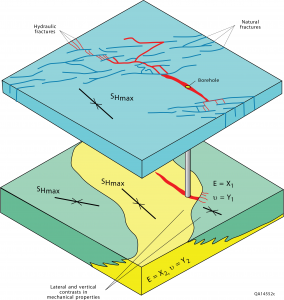
Hydraulic & natural fractures
Structural geology emerged as an applied geoscience discipline providing predictive tools in economic geology. Through the subsequent development of quantitative approaches and in conjunction with compositional and isotopic analytical tools, these techniques have provided fundamental insight into deformation processes that shaped our current understanding of global tectonic and planetary processes.
A more recent development within this discipline is the close integration of brittle structural geology with low-temperature geochemistry, structural diagenesis. Among other advances, this structural-diagenetic workflow has enabled insight into coupled physical and chemical processes that control the formation of fractures in the upper crust and their flow properties, with relevance to crustal and basin-scale flow processes, groundwater resources, hydrocarbon exploration and production, CO2 sequestration, and the occurrence of natural and human-induced seismicity.
Recent work in structural diagenesis has shown that fracture opening and cementation are closely coupled processes, with chemical reactions influencing and in part controlling mechanical fracture opening, and physical fracture opening processes impeding or enhancing cement precipitation that reduces fracture flow. At the microscale, fracture opening processes control the rate and texture of fracture cement growth while host rock diagenetic processes control rate of fracture growth, with complex feedback loops among these coupled processes. At the nanoscale, solution and precipitation processes control the structure of grain boundary channels that provide pathways for fluid and mass transport in otherwise completely cemented fractures.
Insight into these processes provides the basis for improved development strategies of conventional and unconventional oil and gas resources, with the aim of reducing the environmental impact associated with exploration and production including land and water resource utilization.
Peter Eichhubl
Stephen E. Laubach
For an account of the role of cement in fracture growth written for the general public: Scientia 2017
For more information on Structural Diagenesis:
Laubach, S.E, P. Eichhubl, C. Hilgers, R.H. Lander, 2010, Structural diagenesis. Journal of Structural Geology 32 (12), 1866-1872. doi:10.1016/j.jsg.2010.10.001 | view
© 2024 Jackson School of Geosciences, The University of Texas at Austin


